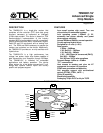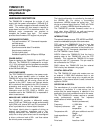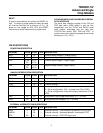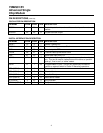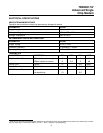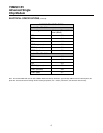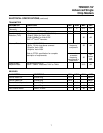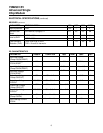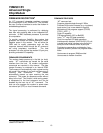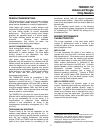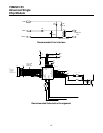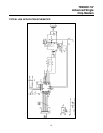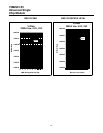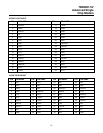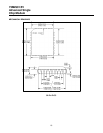
73M2901/5V
Advanced Single
Chip Modem
2
HARDWARE DESCRIPTION
The 73M2901/5V is designed for a single +5 volt
supply with low power consumption (~250mW @ 5
volts). The modem supports automatic standby idle
mode. The modem will also accept a request to
power down from the DTE via hardware control. No
additional major components are required to
complete the modem core logic. The modem
provides direct firmware LED support via port pins.
HARDWARE FEATURES
· Fully self-contained. “AT” Command interpreter
and data pump
· User pin available
· Synchronous serial data I/O available
· Asynchronous serial port
· On-chip hybrid driver.
· Autobaud capability from 300bps to 9600bps
POWER SUPPLY
Power is supplied to the 73M2901/5V via the VPD and
VPA pins. The 73M2901/5V is designed for a single
+5 (+/-10%) volt supply and for low power consumption
(~250mW @ 5 volts). Ground Reference is provided
at the VND and VNA pins.
LOW POWER MODE
The TDK 73M2901/5V supports a low power mode.
If the low power standby option is enabled the
73M2901/5V will go into a power saving mode when
idle. The oscillator will be running, clocks will be
supplied to the UART, timers and interrupt blocks;
but no clocks will be supplied to the CPU. Instruction
processing and activity on the internal busses is
halted. Normal operation is resumed when an
interruption such as DTR, RING or ASRCH (any
character send to the 73M2901/5V) is requested or
when a reset occurs.
ANALOG LINE / HYBRID INTERFACE
The 73M2901/5V provides a differential analog
output (TXAP and TXAN) and a single-ended analog
input (RXA) with internal A/D and D/A converters. A
driver is provided for an internal hybrid function.
The internal hybrid driver is capable of driving an
external load matching impedance and a line-
coupling transformer. If an external hybrid is to be
used, the on-chip hybrid drivers can be reconfigured
to drive a minimum load of 50kW and thus reduce
the driver’s power consumption.
The hybrid configuration is controlled by the state of
the HBDEN pin. For driving a line-coupling
transformer, HBDEN should be pulled high. For
driving an external hybrid (load on TXAP and TXAN
is 50kW or larger), HBDEN should be pulled low.
The 73M2901/5V provides firmware control for a
hook relay driver (RELAY) as well as interrupt
support for a ring detect opto-coupler (RING).
INTERRUPT PINS
The external interrupt sources, DTR, ASRCH and RING,
come from dedicated input pins of the same name.
DTR informs the 73M2901/5V that the host has
requested the 73M2901/5V perform a specific
function. The actual particulars of that function can
be changed by “AT” commands (described in full in
the TDK 73M2901 User’s Guide).
ASRCH informs the 73M2901/5V that the host is
passing data to the 73M2901/5V over the DTE
interface. This instructs the 73M2901/5V to begin
looking for valid “AT” commands. This pin needs to
be connected to the TXD pin.
RING informs the 73M2901/5V that the external
DAA circuitry has detected a ring signal.
CRYSTAL OSCILATOR
The TDK 73M2901/5V single chip modem can use
an external 11.0592 MHz reference clock or can
generate such a clock using only a crystal and two
capacitors. If an external clock is used, it should be
applied to OSCIN.
SPECIFYING A CRYSTAL
The manufacturer of a crystal resonator verifies its
frequency of oscillation in a test set-up, but to
ensure that the same frequency is obtained in the
application, the circuit conditions must be the same.
The TDK 73M2901/5V modem requires a parallel
mode (antiresonant) crystal, the important
specifications of which are as follows:
Mode: Parallel (antiresonant)
Frequency: 11.0592 MHz
Frequency tolerance: ±50 ppm at initial
temperature.
Temperature drift: ±50 ppm additional over full
Range.
Load capacitance: 18pF or 20pF
ESR: 75W max.
Drive level: Less than 1mW.



